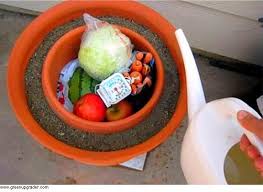 The zeer (pot) (Arabic) or pot cooler consists of a large pot ( e.g .flower pot ) of porous ceramics, containing a smaller pot. The intermediate space is filled with sand, and filled up with water. Fix the inner pot with a heavy lid , so he does not float. The inner should be enamel or waterproof material. In this your food or drink is stored.
The zeer (pot) (Arabic) or pot cooler consists of a large pot ( e.g .flower pot ) of porous ceramics, containing a smaller pot. The intermediate space is filled with sand, and filled up with water. Fix the inner pot with a heavy lid , so he does not float. The inner should be enamel or waterproof material. In this your food or drink is stored.
The water migrates slowly to the outside, in order to evaporate there. This extracts heat from the inner pot, which stays cool. This principle is also used for sweating , or if you are wrapping a bottle in a damp (not wet) cloth. This humidification cooling (or evaporative cooling) works in a dry environment with low humidity.
In a simplified version water (or drinks) keeps cool long in an earthenware pot covered with a damp cloth. (Old farmers used this in summer in the field.)
Through the wall of unglazed pottery liquid can vaporize causing its temperature decreases by 3 to 4 degrees C. In hot countries people used such gargoulettes or jars on the windowsill as airco to cool.
The traditional Afghan way of storing grapes for 6 to 12 months: they are placed in an earthenware bowl, the "Kangeena" (also kangina, made of clay). Over it comes a similar bowl, closing like an oyster shell. The edges are covered with mud (I suppose clay). The grapes consume all oxygen, so they no longer spoil. The whole is then buried. It would also be used for olives and pears.
In ancient Irish and Scottish peat soil is found 274 times bog-butter by archaeologists. (In other countries also 150 times.) Too often to be a coincidence. Butter was very nutritious and costly. The butter was packed in baskets, bark, skins or wooden boxes. The soil is cold, wet and oxygen poor. One could bury it during the abundance in the summer months, to save it for years or centuries, salt free. (Possible but less likely butter was also used as a fuel.)
